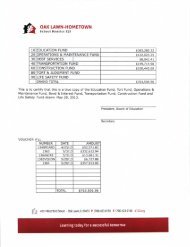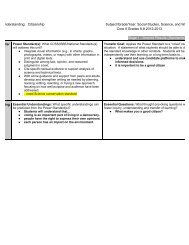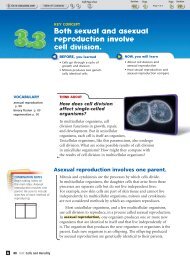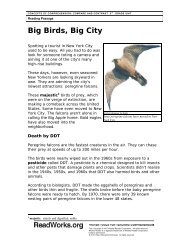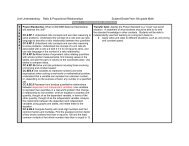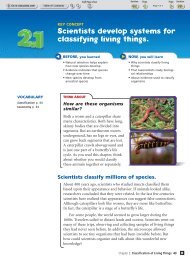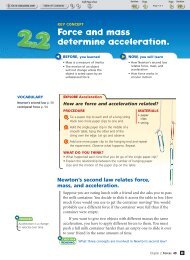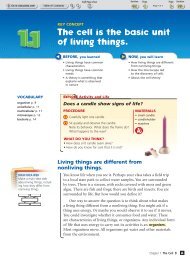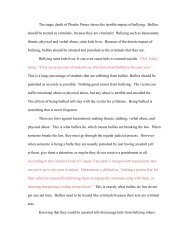(3.2) Cell division is part of the cell cycle. - Durant Road Middle School
(3.2) Cell division is part of the cell cycle. - Durant Road Middle School
(3.2) Cell division is part of the cell cycle. - Durant Road Middle School
Create successful ePaper yourself
Turn your PDF publications into a flip-book with our unique Google optimized e-Paper software.
Interphase<br />
Interphase <strong>is</strong> <strong>the</strong> <strong>part</strong> <strong>of</strong> <strong>the</strong> <strong>cell</strong> <strong>cycle</strong> during which a <strong>cell</strong> <strong>is</strong> not<br />
dividing. Much activity takes place in th<strong>is</strong> phase <strong>of</strong> <strong>the</strong> <strong>cell</strong>’s life.<br />
During interphase, <strong>the</strong> <strong>cell</strong> grows to about twice <strong>the</strong> size it was when<br />
it was first produced. The <strong>cell</strong> also engages in normal life activities,<br />
such as transporting materials in and transporting wastes out. Also,<br />
<strong>cell</strong>ular respiration occurs, which provides <strong>the</strong> energy <strong>the</strong> <strong>cell</strong> needs.<br />
Changes that occur during interphase prepare a <strong>cell</strong> for <strong>div<strong>is</strong>ion</strong>.<br />
Before a <strong>cell</strong> can divide, it duplicates its DNA exactly. Correct copying<br />
<strong>of</strong> <strong>the</strong> DNA <strong>is</strong> very important. It ensures that, after <strong>cell</strong> <strong>div<strong>is</strong>ion</strong>, each<br />
new <strong>cell</strong> gets a complete set <strong>of</strong> DNA. During most <strong>of</strong> interphase, <strong>the</strong><br />
DNA <strong>is</strong> in chromatin form.<br />
VOCABULARY<br />
Make a frame game<br />
diagram for interphase.<br />
Check Your Reading<br />
What <strong>cell</strong> processes occur during interphase?<br />
<strong>Cell</strong> Div<strong>is</strong>ion Phase<br />
Mitos<strong>is</strong> <strong>is</strong> <strong>the</strong> <strong>part</strong> <strong>of</strong> <strong>the</strong> <strong>cell</strong> <strong>cycle</strong> during which <strong>the</strong> nucleus divides.<br />
Prokaryotes do not undergo mitos<strong>is</strong> because <strong>the</strong>y have only one chromosome<br />
and no nucleus. In most <strong>cell</strong>s, mitos<strong>is</strong> <strong>is</strong> <strong>the</strong> shortest period<br />
in <strong>the</strong> life <strong>cycle</strong>. The function <strong>of</strong> mitos<strong>is</strong> <strong>is</strong> to move <strong>the</strong> DNA and<br />
o<strong>the</strong>r material in <strong>the</strong> parent <strong>cell</strong> into position for <strong>cell</strong> <strong>div<strong>is</strong>ion</strong>. When<br />
<strong>the</strong> <strong>cell</strong> divides, each new <strong>cell</strong> gets a full set <strong>of</strong> DNA and o<strong>the</strong>r <strong>cell</strong><br />
structures. Cytokines<strong>is</strong> (SY-toh-kuh-NEE-sihs) <strong>is</strong> <strong>the</strong> <strong>div<strong>is</strong>ion</strong> <strong>of</strong> <strong>the</strong><br />
parent <strong>cell</strong>’s cytoplasm. Cytokines<strong>is</strong> occurs immediately after mitos<strong>is</strong>.<br />
<strong>Cell</strong> Cycle<br />
The events that happen during <strong>the</strong> life<br />
<strong>of</strong> a <strong>cell</strong> are called <strong>the</strong> <strong>cell</strong> <strong>cycle</strong>.<br />
1<br />
Interphase<br />
The <strong>cell</strong> <strong>cycle</strong> begins<br />
with interphase, which<br />
<strong>is</strong> <strong>the</strong> longest <strong>part</strong> <strong>of</strong><br />
<strong>the</strong> <strong>cell</strong> <strong>cycle</strong>.<br />
<strong>cell</strong> grows and carries<br />
out normal functions;<br />
organelles duplicate<br />
reading tip<br />
The arrows in <strong>the</strong> <strong>Cell</strong> Cycle<br />
diagram represent <strong>the</strong> passage<br />
<strong>of</strong> time. Interphase <strong>is</strong><br />
in red, mitos<strong>is</strong> <strong>is</strong> in purple,<br />
and cytokines<strong>is</strong> <strong>is</strong> in yellow.<br />
INTERPHASE<br />
2<br />
<strong>Cell</strong> Div<strong>is</strong>ion<br />
Phase<br />
After mitos<strong>is</strong> and<br />
cytokines<strong>is</strong> <strong>the</strong>re<br />
are two <strong>cell</strong>s. The <strong>cell</strong><br />
<strong>cycle</strong> <strong>the</strong>n begins<br />
again for each <strong>cell</strong>.<br />
MITOSIS<br />
CYTOKINESIS<br />
Telophase<br />
Anaphase<br />
Metaphase<br />
Prophase<br />
<strong>cell</strong> grows<br />
and prepares<br />
for mitos<strong>is</strong><br />
DNA replicates<br />
and chromosomes<br />
duplicate<br />
Chapter 3: <strong>Cell</strong> Div<strong>is</strong>ion 81<br />
EA



